1lumen selects and reviews products personally. We may earn affiliate commissions through our links, which help support our testing.
Speras M4 review
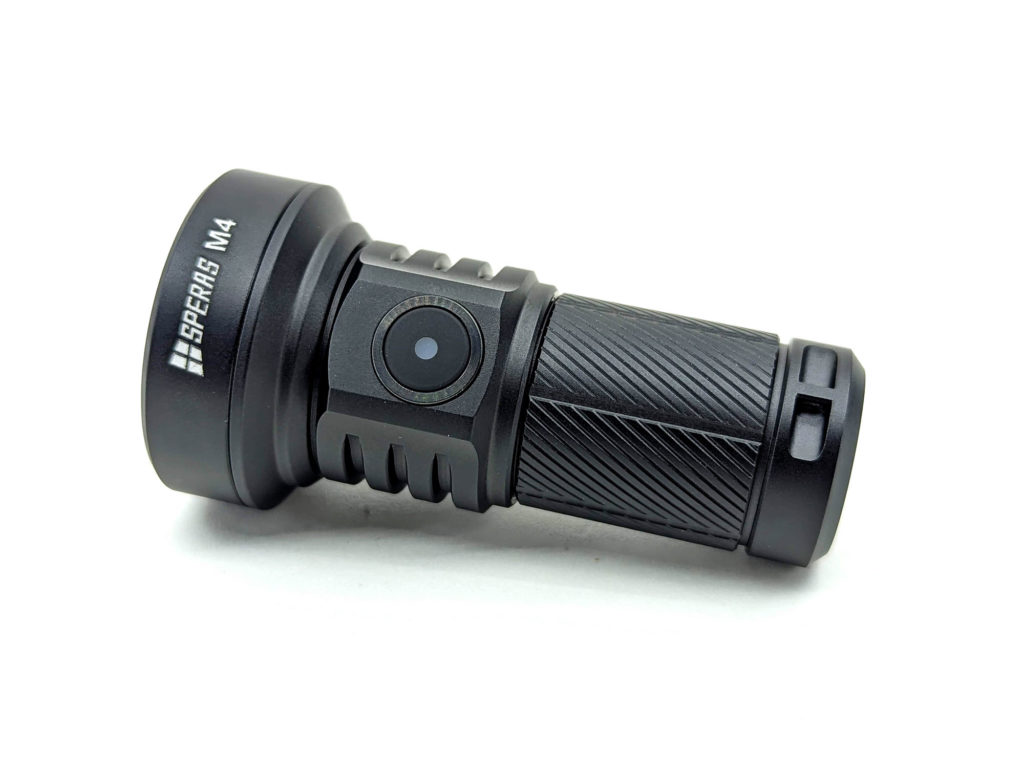
Speras M4 specifications
| Brand & Model | Speras M4 |
|---|---|
| LED | N/A |
| Lumens | 1,320 Lumens |
| Beam intensity | 106,400 cd |
| Battery config. | 1*18350 |
| Onboard charging | USB-C |
| Modes | 5 |
| Blinkies | Strobe / SOS |
| Reflector | TIR optics |
| Waterproof | IP68 |
| Review publication date | July 2022 |
Introduction:
Speras? Who? Frankly, before this review, I hadn’t had any experiences with Speras. I had heard of them a time or two recently but that was it. So I’ll forgive you if the same goes for you. When I come across a new flashlight brand (well, at least new to me), I don’t have the highest of expectations. Honestly, I brace myself for mediocre fit & finish, poor regulation, and a terrible UI. So when the Speras M4 arrived at my doorstep and I first opened the box… well, I’ll let you find out as you read more.
The Speras M4 is a new, compact “pocket thrower”. It boasts 1320 lumens and over 100kcd in a small 18350 form factor that’s just over 3 inches (78mm) long. And of course it has built-in USB-C charging (because what doesn’t these days?). That leaves a bit to live up to. So let’s see how it actually is…
Package quality.
The packaging for the Speras M4 is neither impressive, nor disappointing. I’ve seen my share of brown cardboard boxes, and this is certainly a step up. That said, the Speras came in a pretty plain looking white box with a hanger for display racks. The box itself is almost entirely white with just the name and a couple key specs on the front. The back has a little chart and a description. Basic and to the point. Inside the box is a little plastic tray with the contents:
- Speras M4
- Battery (in the flashlight)
- USB charging cable
- Spare o-rings
- Lanyard
- Manual
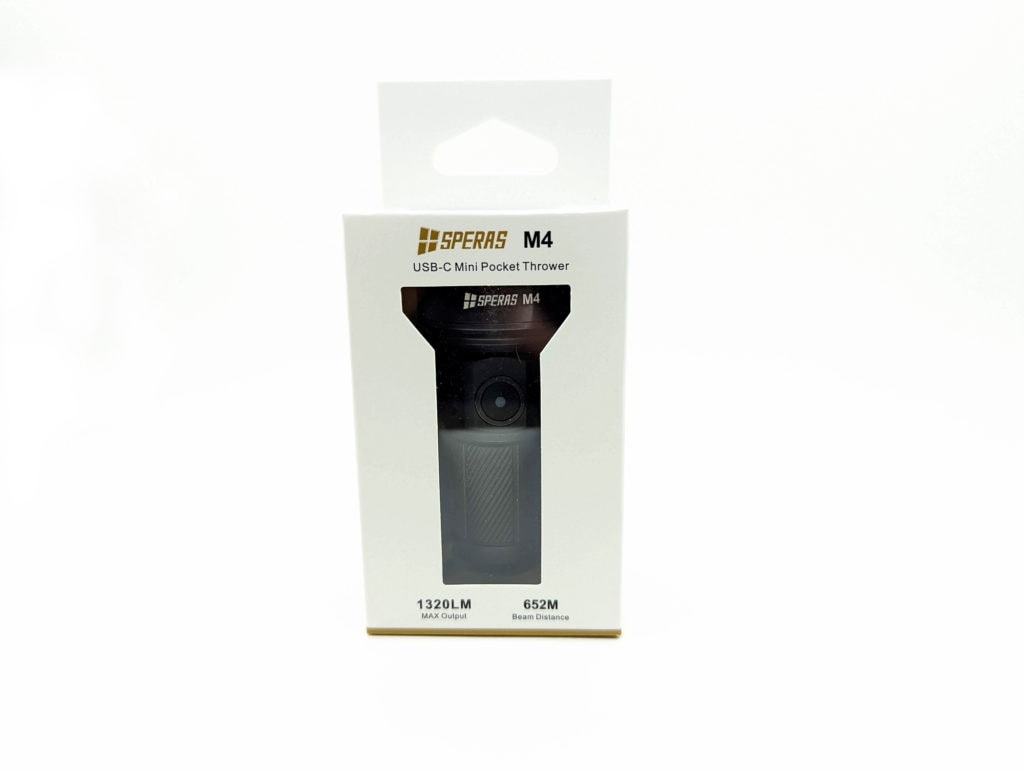
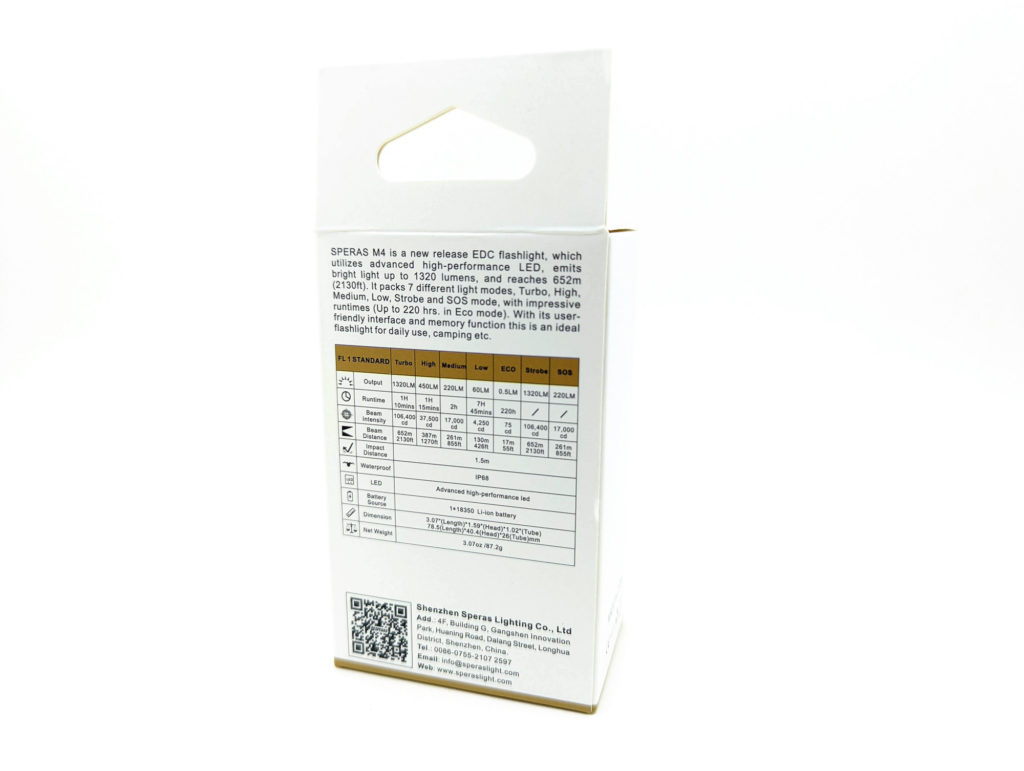
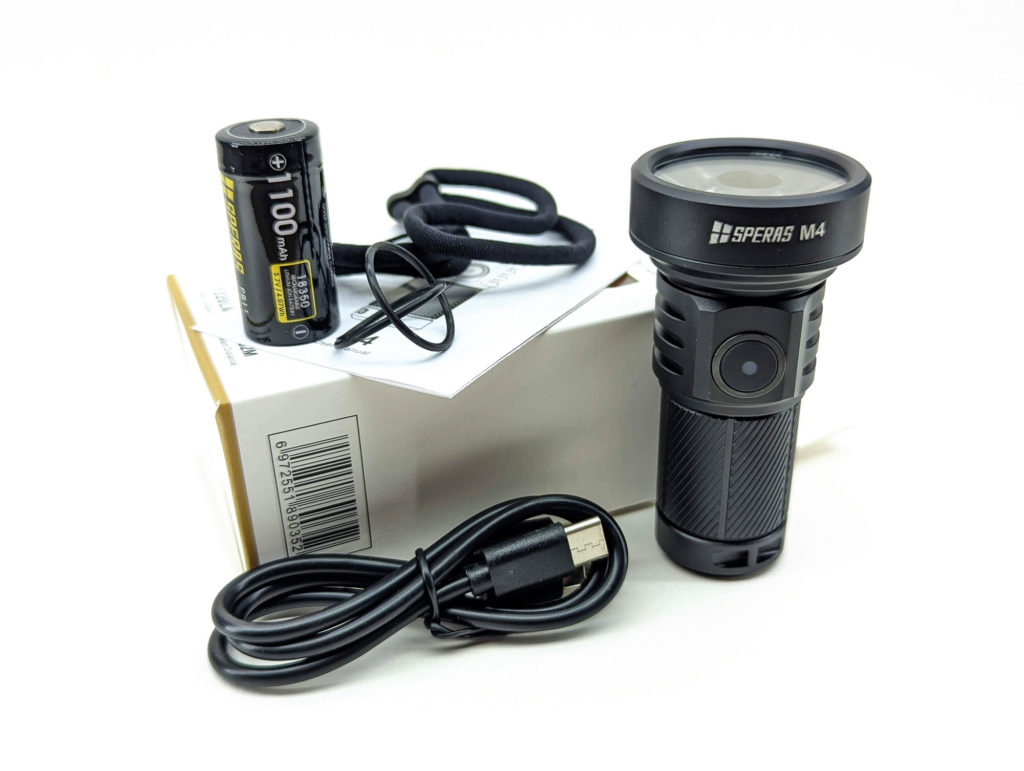
Flashlight in use
The Speras M4 is smaller than I had anticipated. It doesn’t quite fill up my medium-sized palm. The 18350 tube on this makes it very short, though the thrower head on it gives the top end a bit of girth. There’s not much grip to it unless your fingers grip the heatsink fins (which they probably will due to it’s small size).
The wider head on this thing makes it chunkier than I would typically carry in my pocket. But if I felt I was going to be in a situation where I’d want a thrower but still wanted it to be compact, this would be a great contender in that category.
The tail is very flat and so it tailstands easily. There is nothing to keep it from rolling around when laid on its side, so be careful of that. The lanyard is of pretty decent quality and the attachment point is nicely machined.
This is a mini thrower, so it’s good for things like scanning the backyard for odd critters. I could see carrying it for hikes in the woods and other moderate-range duties.
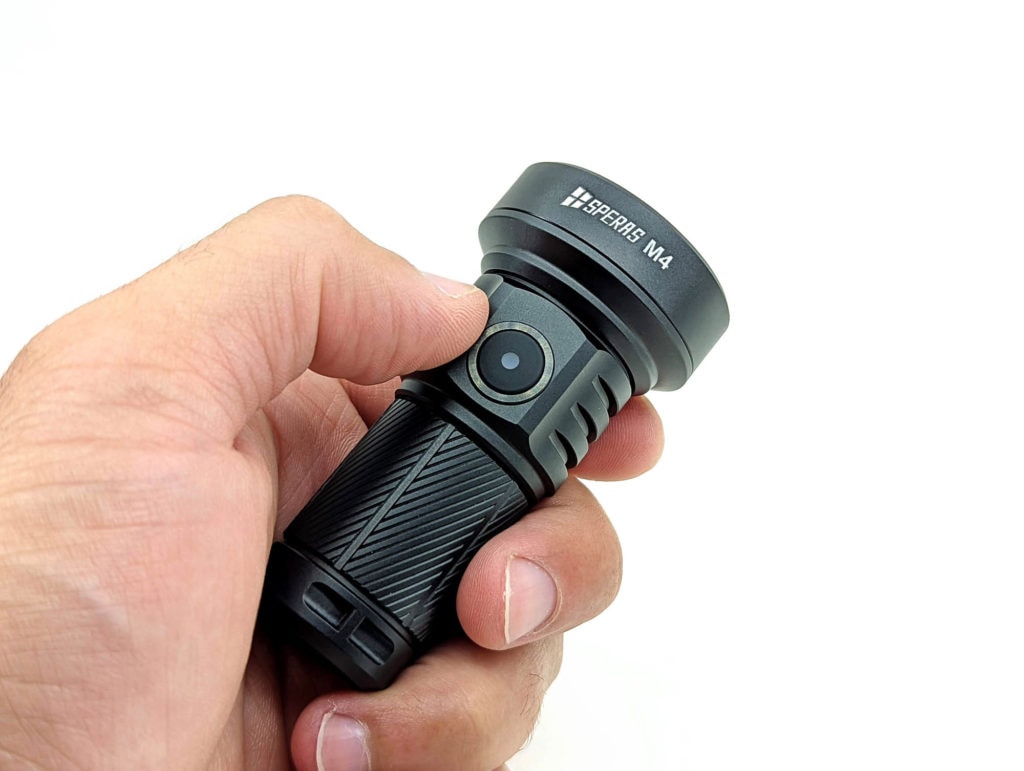
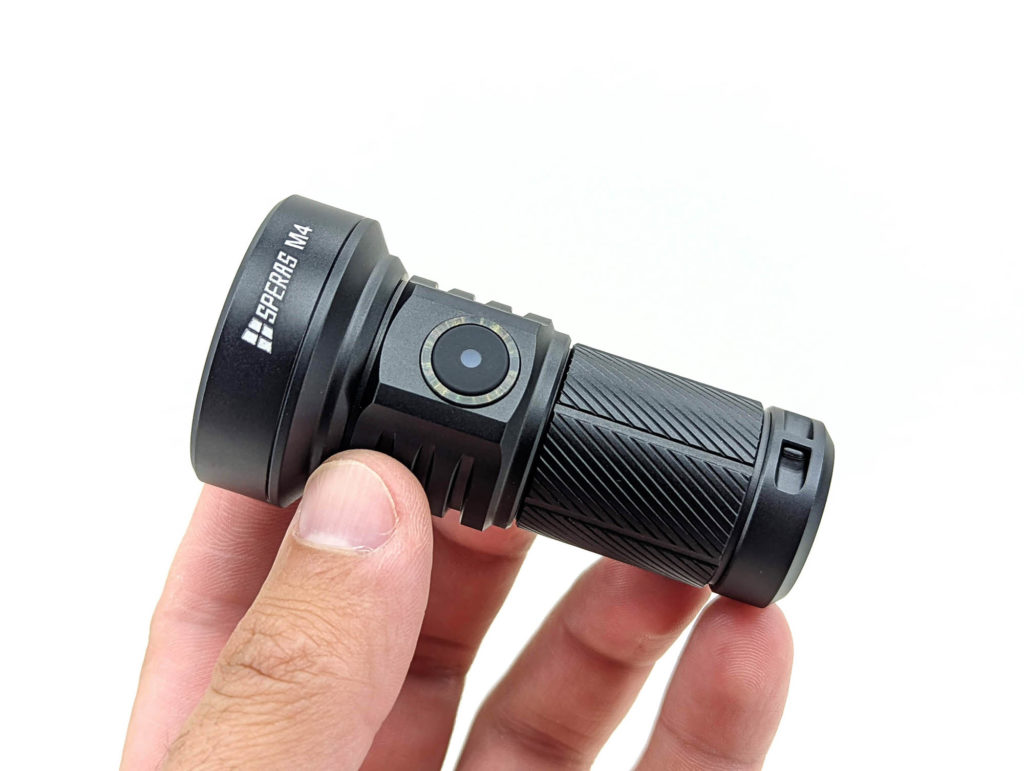
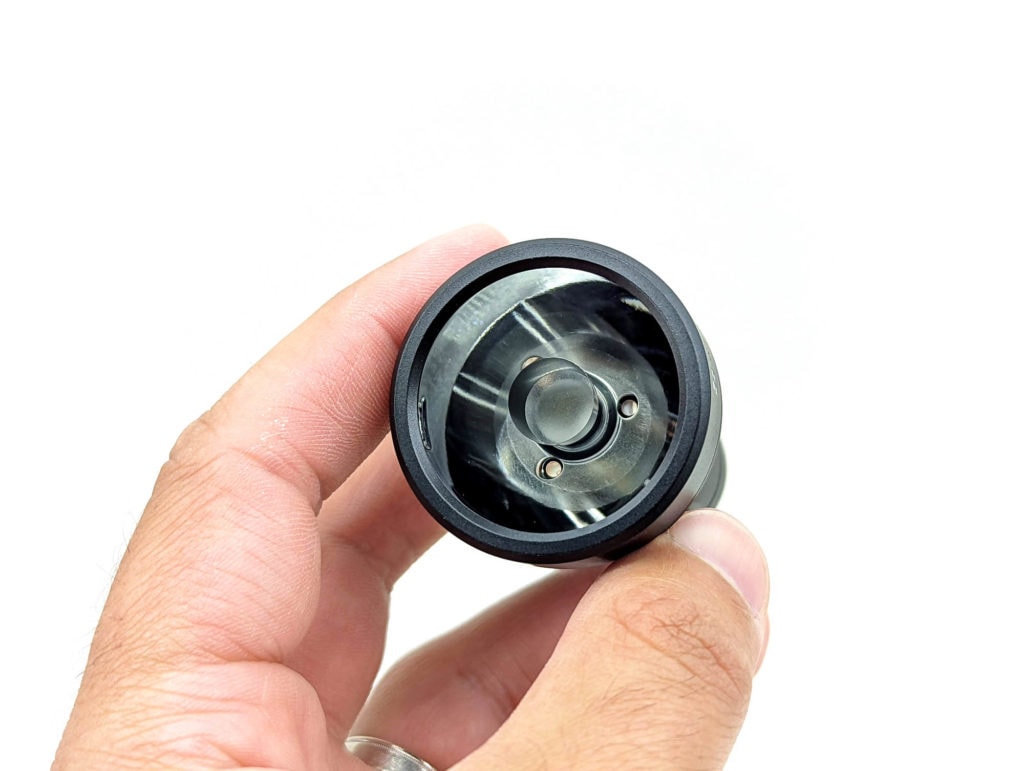
Build Quality, and Warranty
Woah boy… so you know how I said my “fit & finish” expectations were really low? Well, I can take that idea and crumple it up and send it up in flames. I was legitimately shocked when I removed the Speras M4 from the package and held it for the first time. It feels great. The spiral pattern cut into the battery tube is expertly done. The tail end is nicely chamfered. Everything fits together perfectly. And the anodizing… it’s Type III Hard-Anodized and a very well done satin sheen. It ranks up there with the best of them that I have from Nitecore, Wuben, Acebeam, Olight, etc. I don’t know if Speras has more experience than I give them credit for or if they have a big industry partner or something – but I feel like they really punched above their weight class in the build quality department.
Warranty:
- The light is covered by a 5 year warranty for “non-artificial” damage
- The warranty does not cover normal wear & tear, modifications, misuse, etc
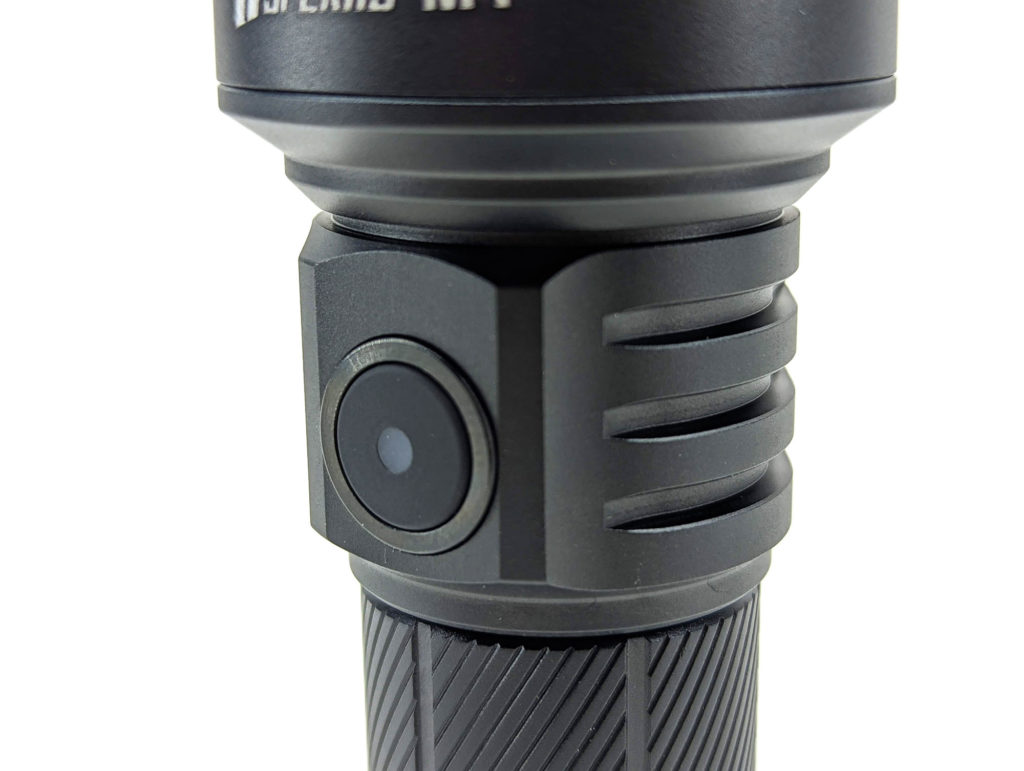
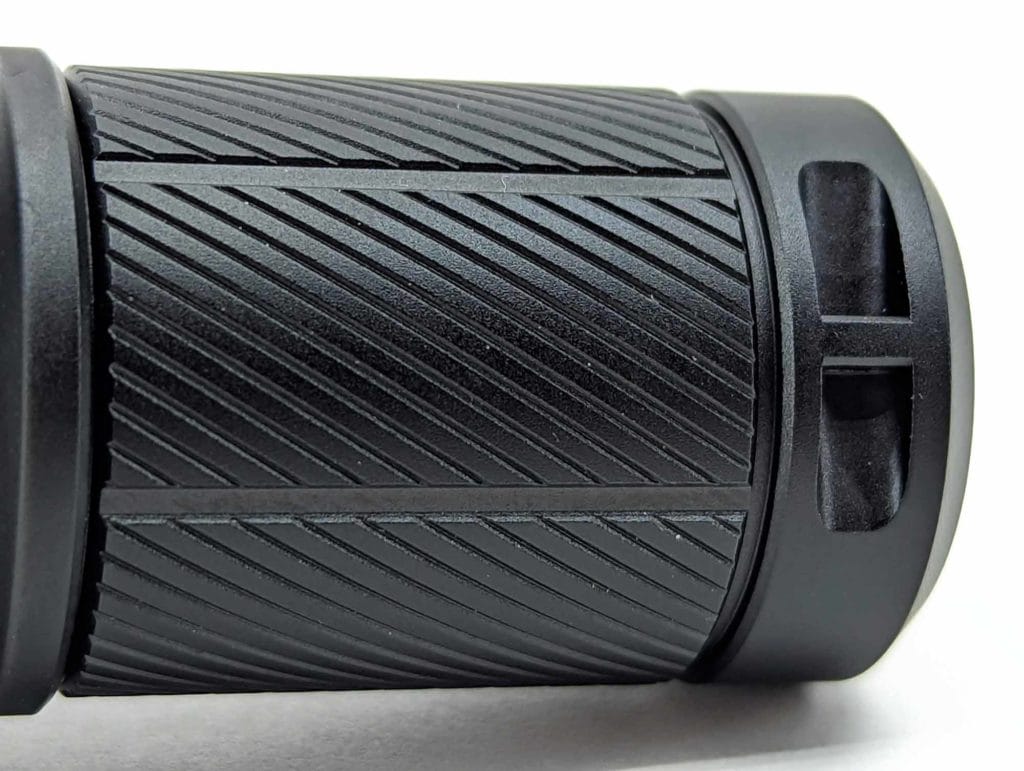
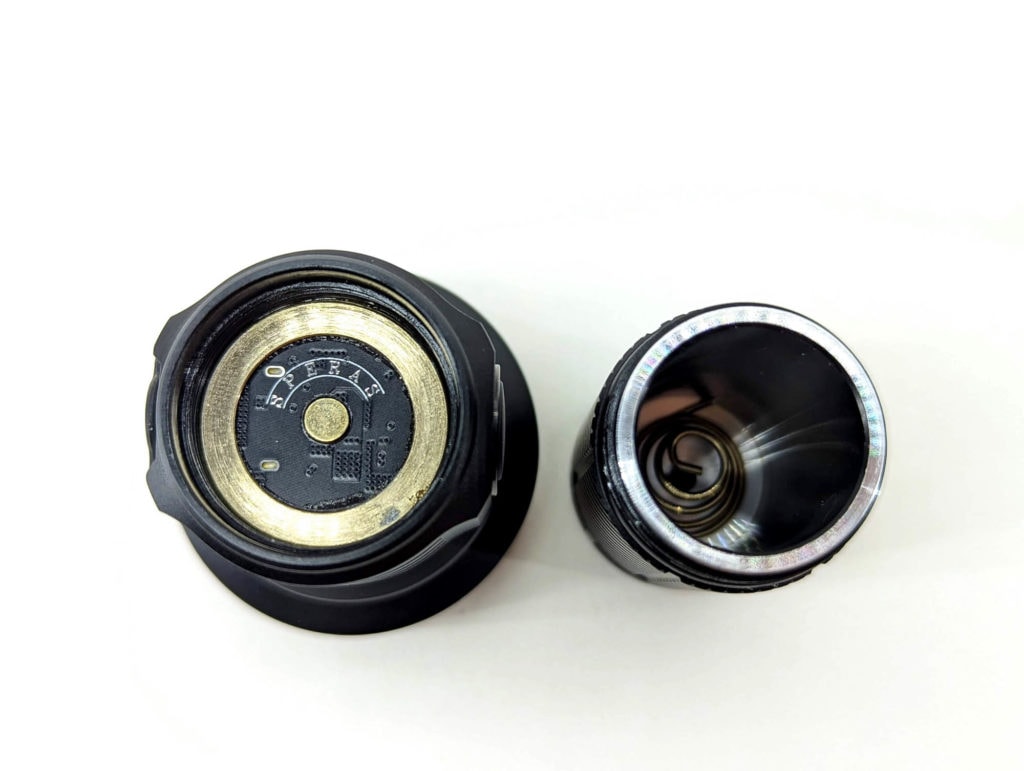
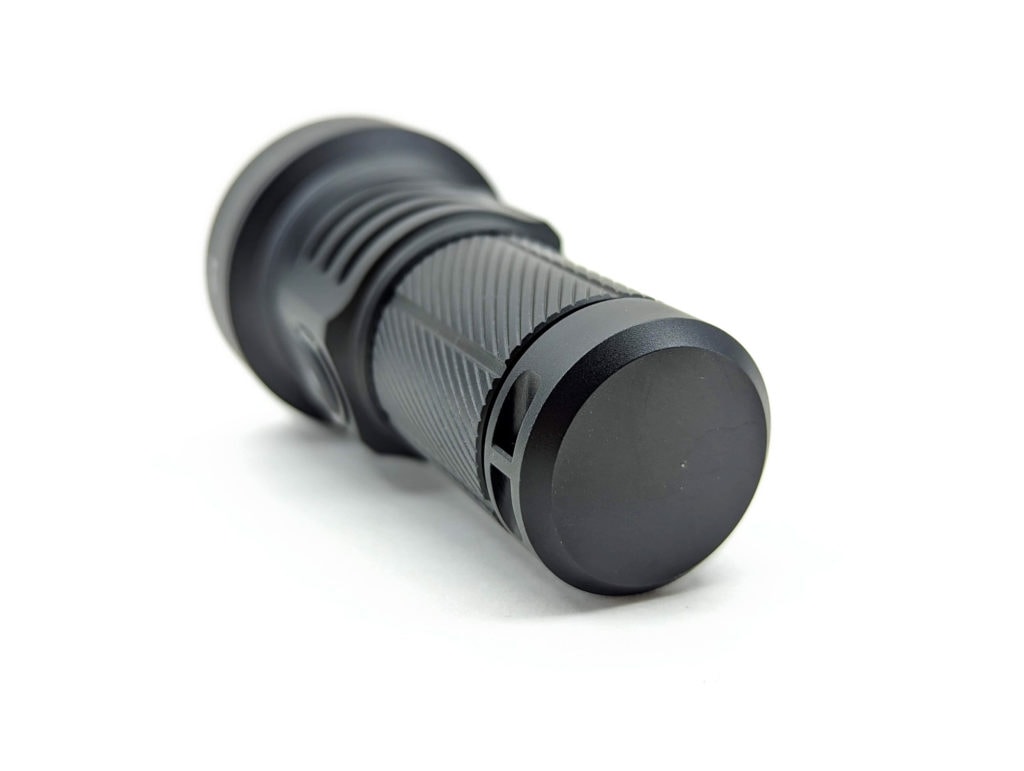
LED, Lens, Bezel, Beam, and Reflector
The LED was a bit of a mystery. Speras simply says that it’s a “high-performance LED”. Well, I would certainly hope so. Not satisfied with that information, I unscrewed the bezel (no glue!) and carefully set it aside with the glass it contained. After that, I cautiously pried out the PMMA TIR lens to reveal the LED underneath. Lo and behold, it’s what we (the members of BudgetLightForum) have simply referred to as the “YinDing 5050 LED”, neutral white version. This emitter is rather unusual due to its completely round die. That round die is pretty neat. But unfortunately this LED is also known to be quite green. The Opple Light Master readings back this up:
Readings at 3 meters, Low Mode:
- CCT: 5130K
- CRI: 58.3 Ra
- DUV: +0.0174
Readings at 3 meters, Turbo Mode:
- CCT: 5210K
- CRI: 64.6 Ra
- DUV: +0.0112
Green? You bet it is. Well, at least that’s what the Opple says. This is the one time in my life when I’m kinda glad to be red-green colorblind. I hardly notice it. But if you’re sensitive to green tints – beware.
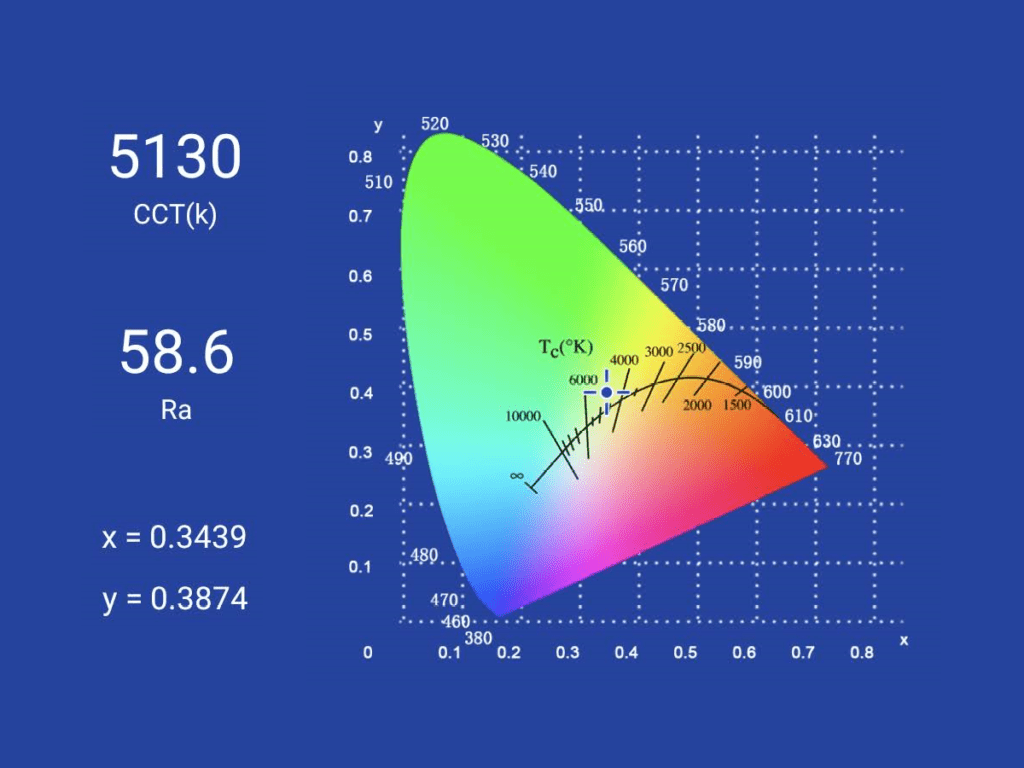
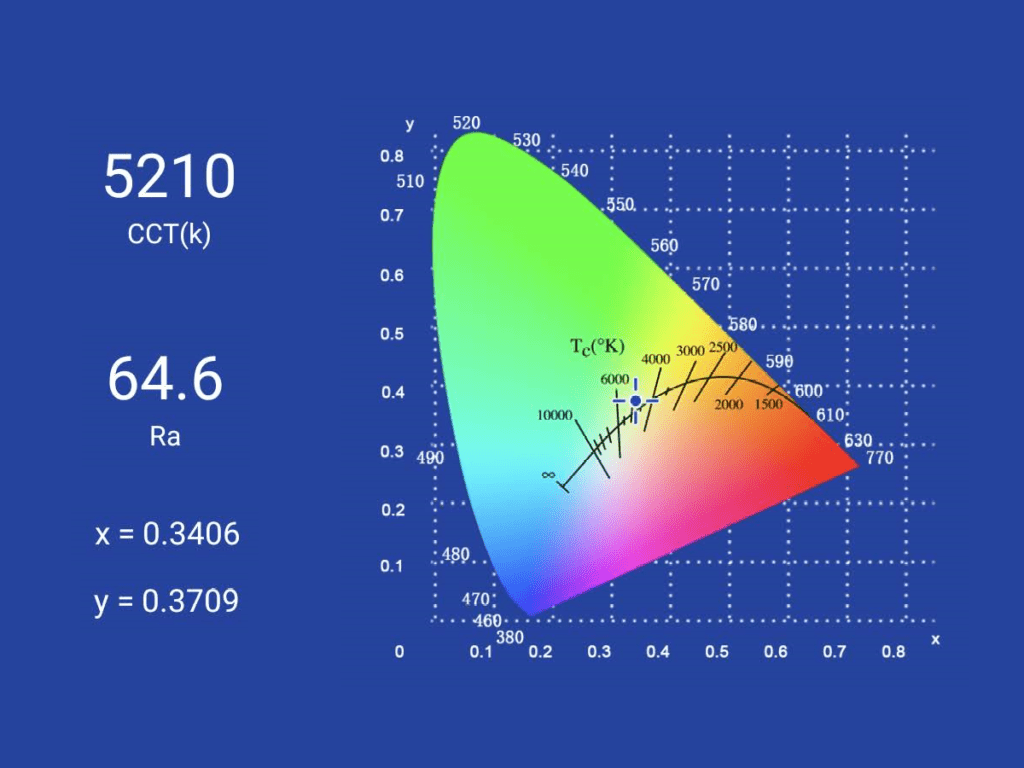
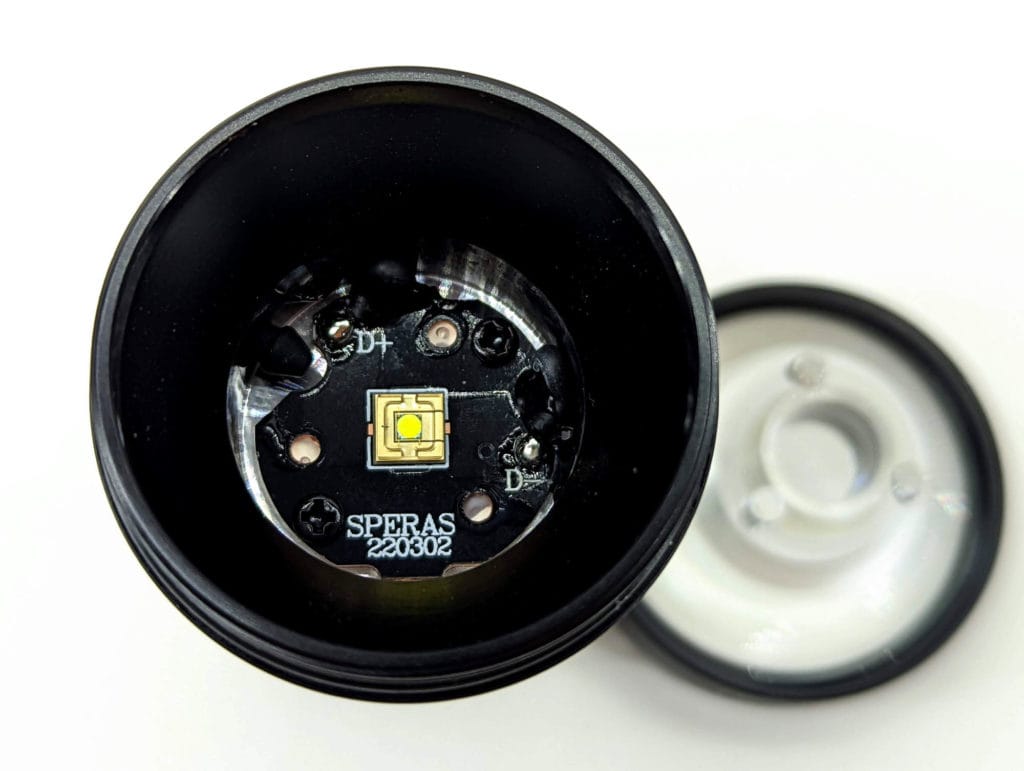
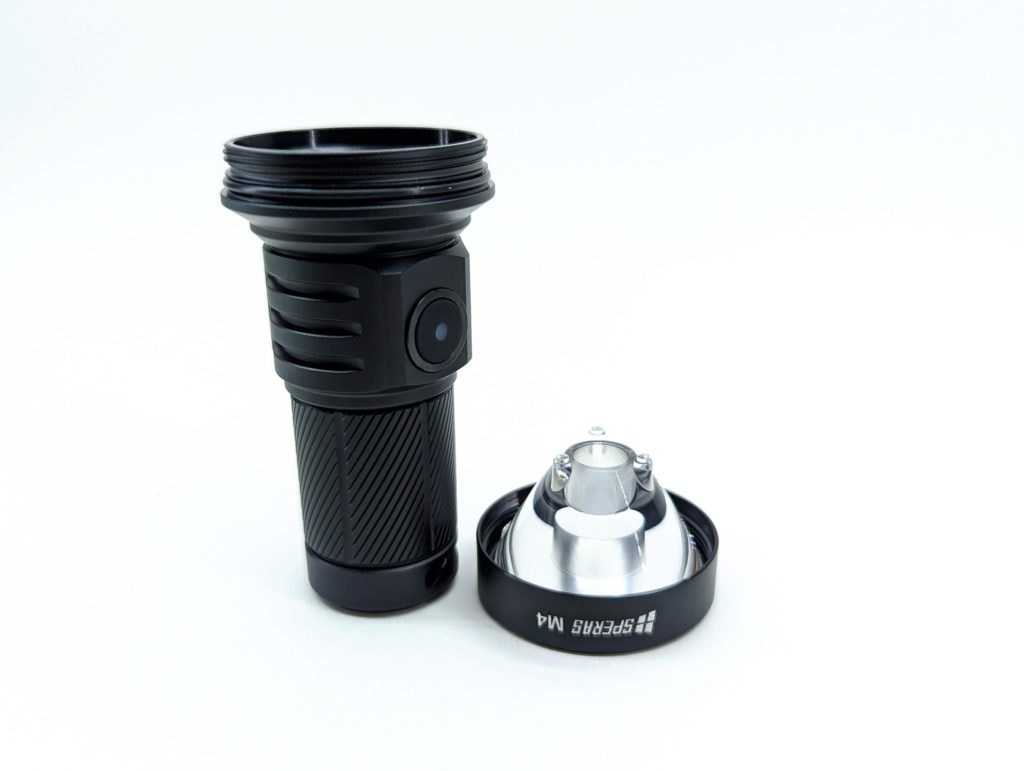
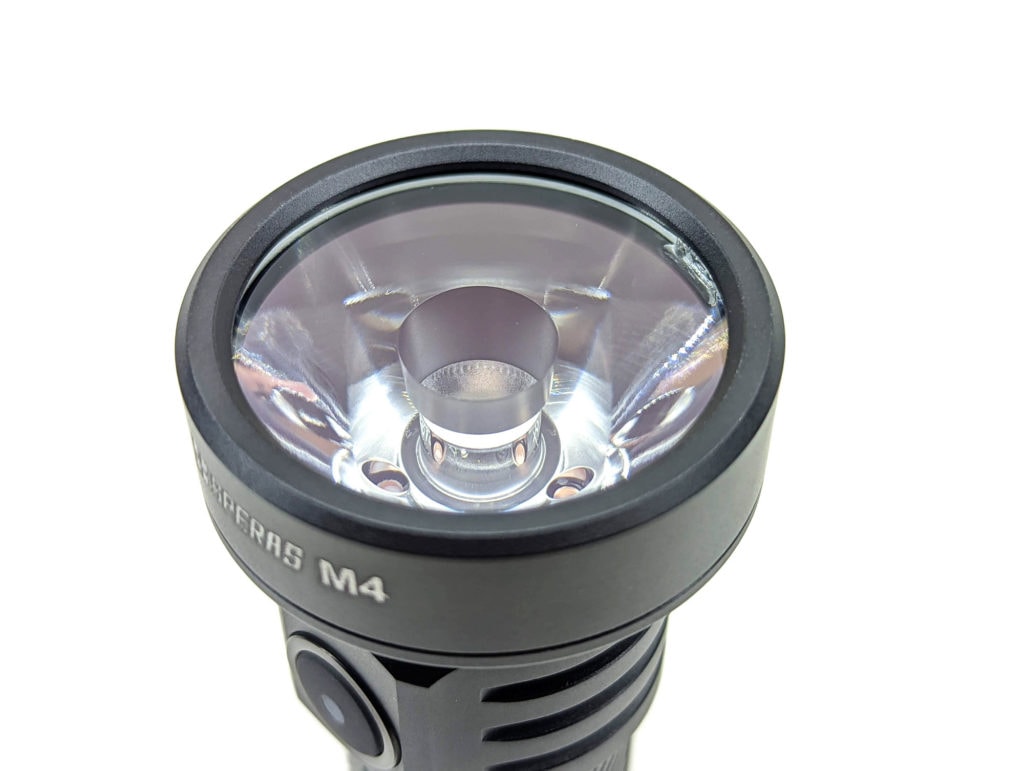
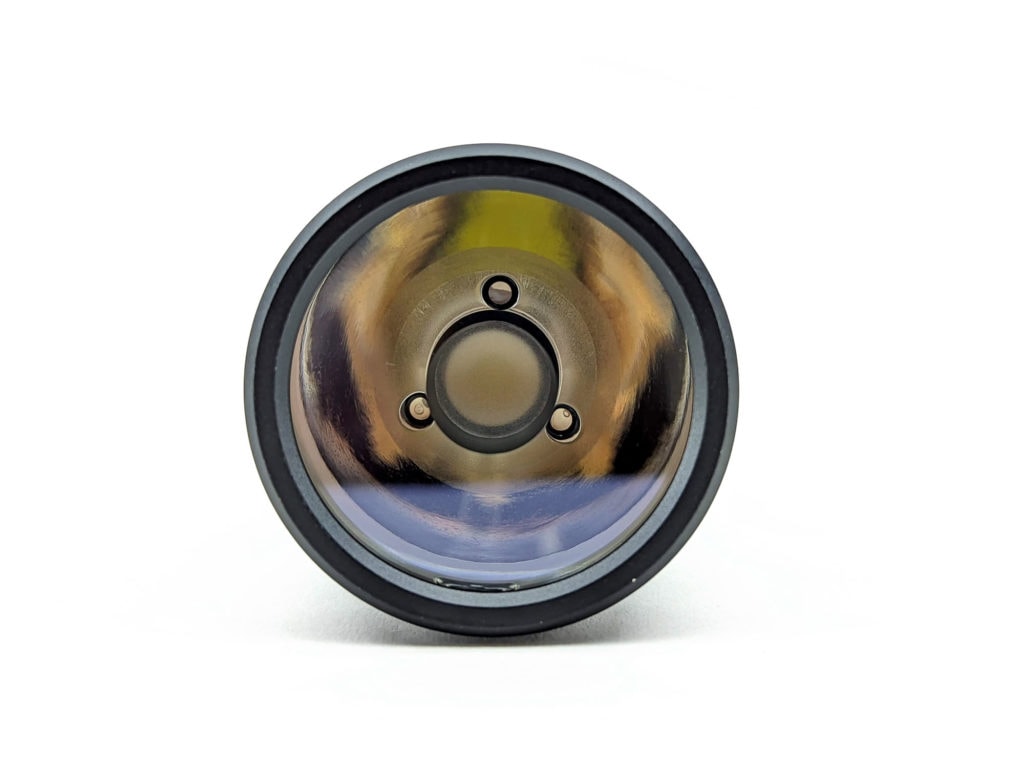
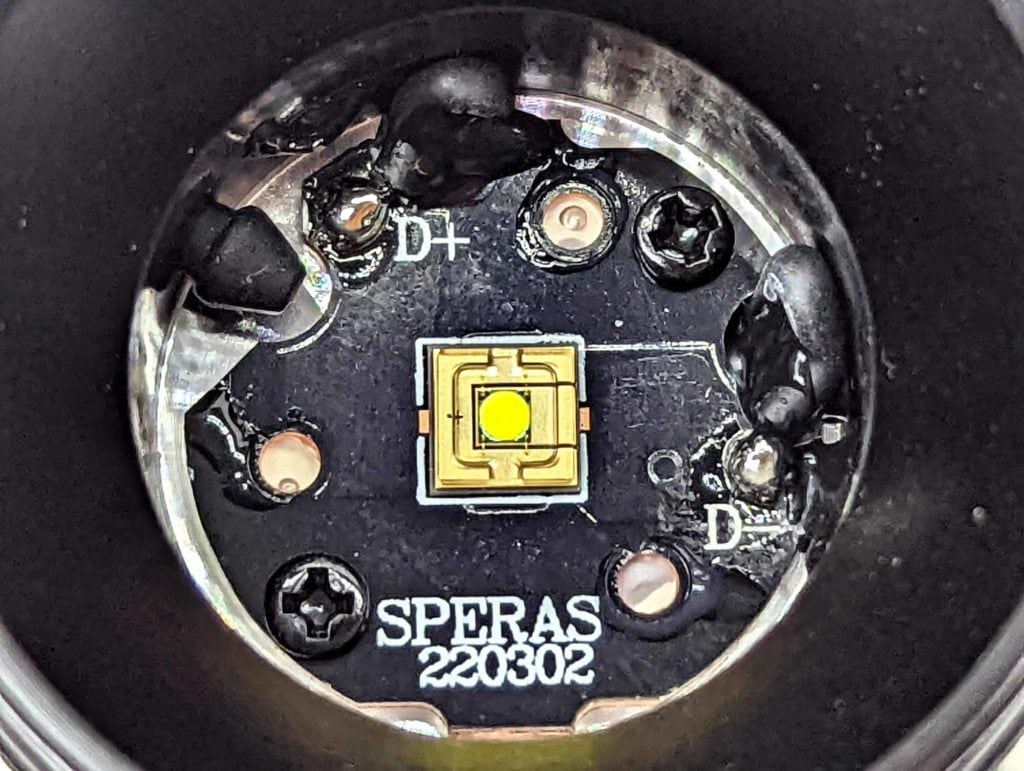
Dimensions and size comparison
Dimensions:
| Dimension | Millimeters | Inches |
|---|---|---|
| Length | 78.5 | 3.07 |
| Head diameter | 40.4 | 1.59 |
| Body diameter | 26 | 1.02 |
Weight:
| Weight | Grams | Oz. |
|---|---|---|
| Without battery: | 87.2 | 3.07 |
| With battery | 113 | 3.99 |
Flashlight comparison
Group 1: Manker MC13, Speras M4
Group 2: Lumintop GTA, Speras M4, Wuben E6
When I saw the Speras M4 online, one of my first thoughts was “look, another Manker MC13”. But no – these are quite different lights. The Speras is appreciably smaller and it adds USB-C charging. The Manker has a tail e-switch (Speras has a side switch) and a decent pocket clip (the Speras has no clip). So there certainly are notable differences. I don’t personally own the ThruNite Catapult Mini, but that is another light that immediately came to mind. Its dimensions and design are extremely similar, though it’s output is much less than the Speras.
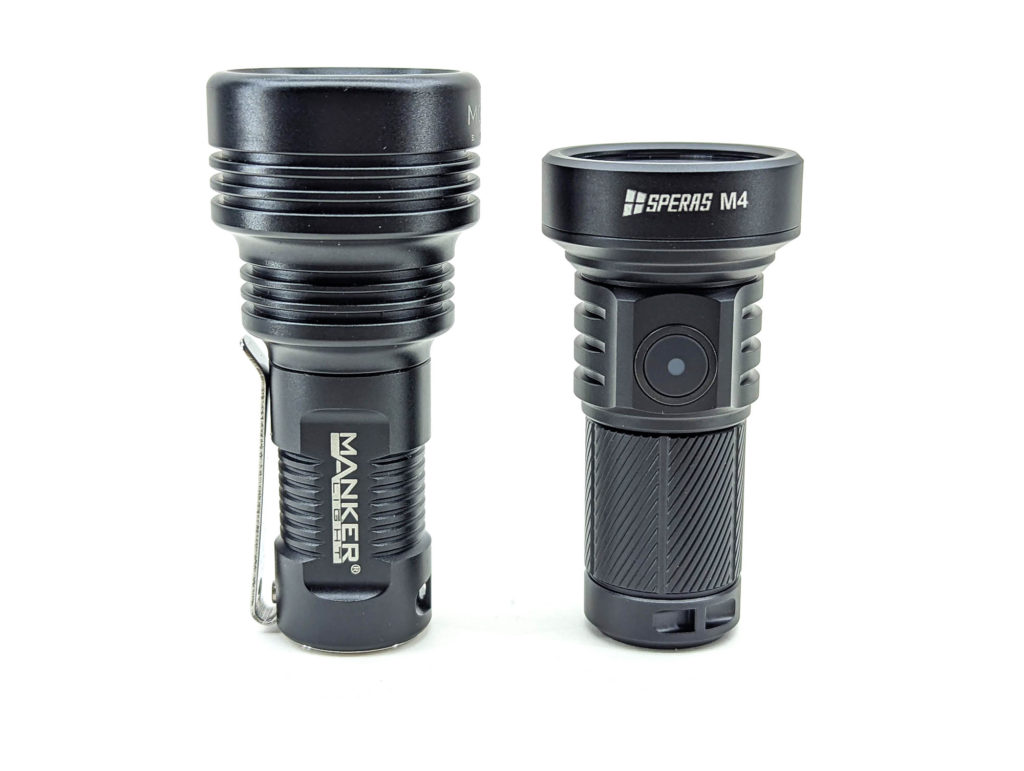
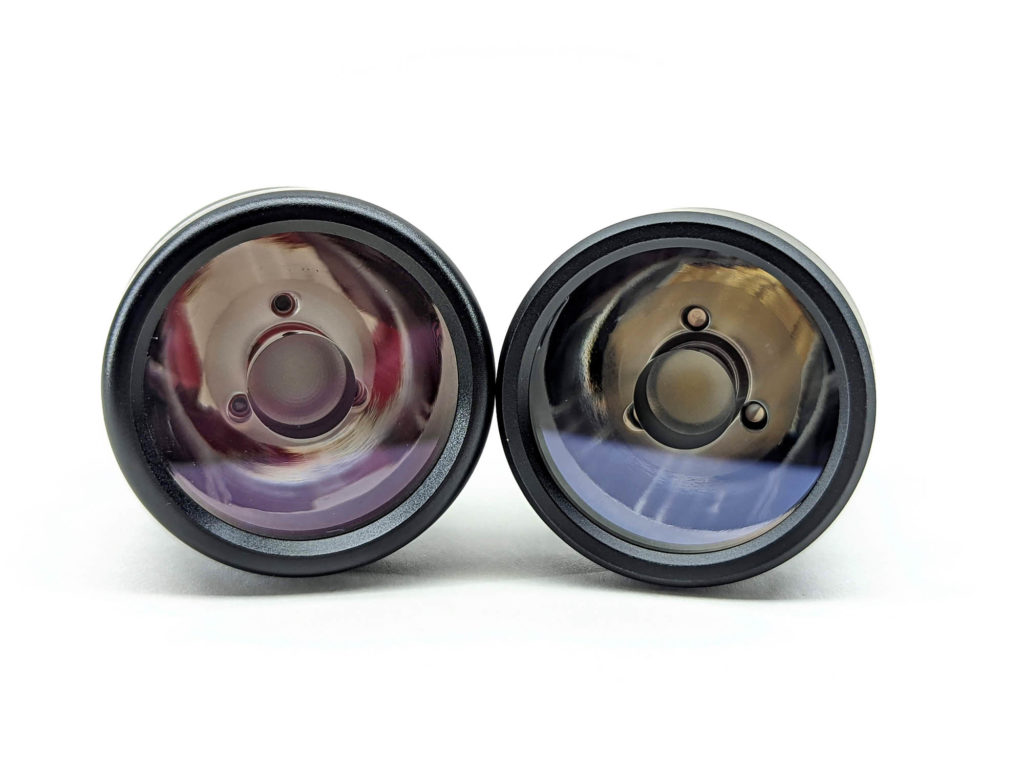
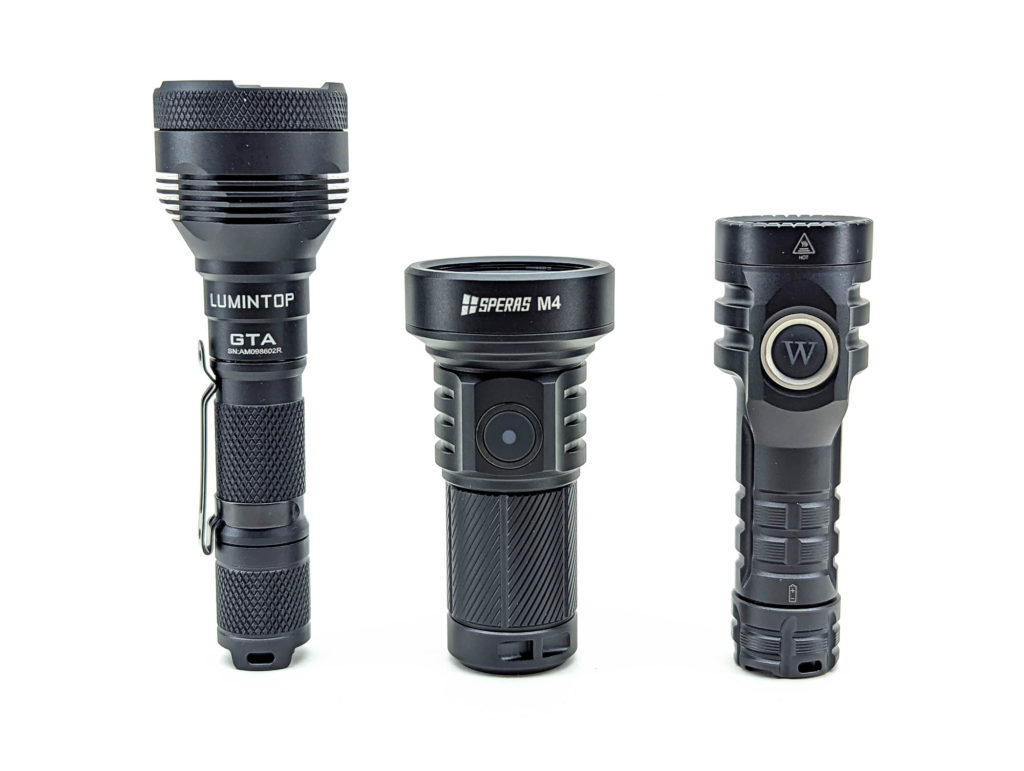
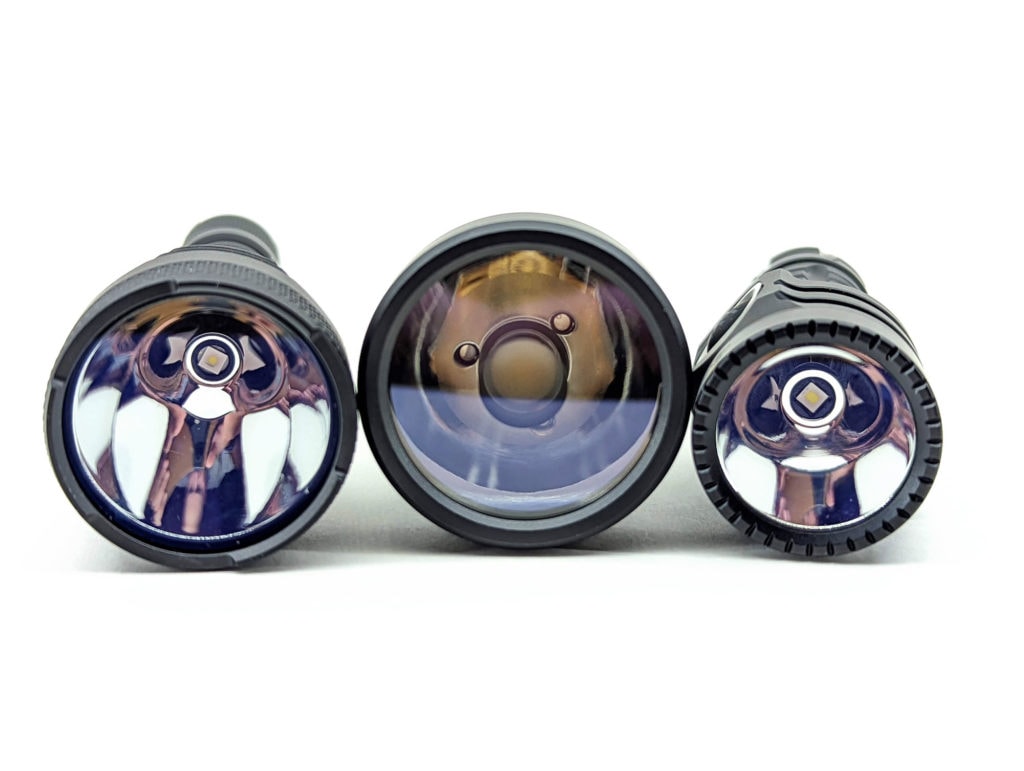
Driver & User Interface:
There are some e-switch UI’s that are nearly universal and quick to pick up on. And then there are others that I try to use and I think to myself “oh, why did you have to go and ruin a nice light by giving it a terrible UI?” Thankfully, the Speras M4 belongs to the former camp. The UI is intuitive and natural.
Available modes: Eco, Low, Medium, High, Turbo
Available blinky modes: Strobe, SOS
User interface:
From OFF:
- Press and Hold: Eco mode
- Single click: turn on (memorized mode)
- Double click: Turbo mode
- 3 clicks: Strobe mode
- Hold 2 seconds: Lockout mode
From ON:
- Press and Hold: change brightness (Low > Medium > High)
- 1 click: turn off
- Double click: Turbo Mode
- 3 clicks: Strobe Mode
Mode memory:
- Yes, it will memorize Low, Medium, and High
Shortcuts:
- To Low: hold 0.5 seconds from Off
- To Turbo: double click from Off or On
- To Strobe: triple click from Off or On
Low voltage warning:
- When turning the flashlight on, the indicator LED in the switch will light up or 5 seconds to indicate the power level:
- Green: 100% – 70%
- Orange: 70% – 30%
- Red: 30% – 10%
- Red Flash: 10% – 1%
Strobe/blinkies
- Strobe is activated by a triple click from Off or On
- When in Strobe Mode triple click to get to SOS Mode
Lock-out mode:
- Activate Lockout by a 2 second hold from Off
- Unlock with a triple click
PWM
- There is no PWM
Additional info on the UI:
- Eco mode (only) can be used while charging
Batteries & Charging
The Speras M4 ships with a Speras-branded 1100 mAh 18350 battery pre-inserted in the light. The “PB11” battery includes a button-top protection circuit and is rated at 6 amps discharge. I also tried a Keeppower flat-top 18350 battery and it worked just fine.
Speras says that the built-in USB-C charging should take around 2 hours to give the M4 a full charge. In my testing, it completed in 2 hours and 13 minutes. The battery ended up at 4.16 volts. The charge rate was 0.65 amps.
The box contained a USB-A to USB-C charging cable that worked just fine for its intended purpose. However, when I tried to charge the M4 with a USB-C to USB-C cable hooked up to my USB-PD supply, it would not charge. That’s not the end of the world, but a good thing to keep in mind – not just any ol’ charger will work
Performance test
Lumen measurements:
For current measurements, an ANENG AN8008 multimeter and UNI-T UT210E clamp meter were used. Lux was measured by a UNI-T UT383 BT at 10 meters. Lumens were measured in a homemade lumen tube using a TSL2591 sensor, calibrated with a Maukka calibration light. Testing was performed with (1) the included Speras PB11 battery.
Lumen measurements (for each mode)
| Mode | Amps at start | Specs | turn on | 30 sec | 10 minutes |
|---|---|---|---|---|---|
| Eco | 6 mA | 0.5 lm | 0.6 lm | 0.6 lm | 0.6 lm |
| Low | 153 mA | 60 lm | 67 lm | 67 lm | 66 lm |
| Medium | 593 mA | 220 lm | 240 lm | 239 lm | 236 lm |
| High | 1.3 A | 450 lm | 528 lm | 524 lm | 508 lm |
| Turbo | 3.7 A | 1320 lm | 1188 lm | 1111 lm | 332 lm |
Parasitic drain:
- 36 µA
Runtime graph
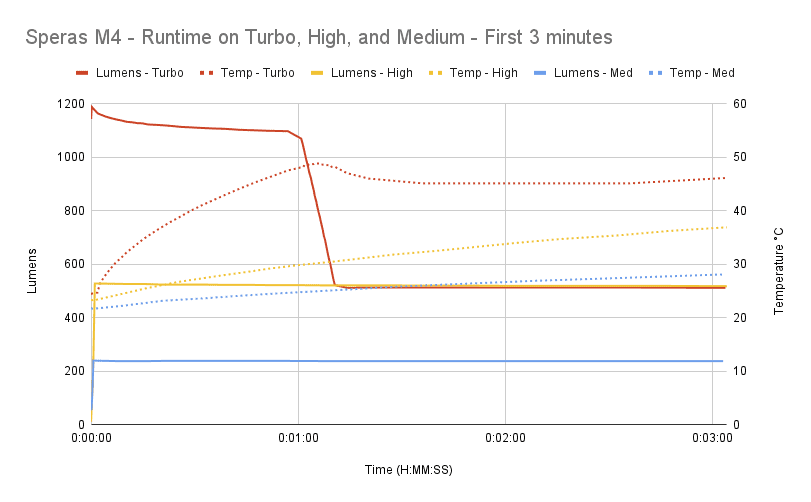
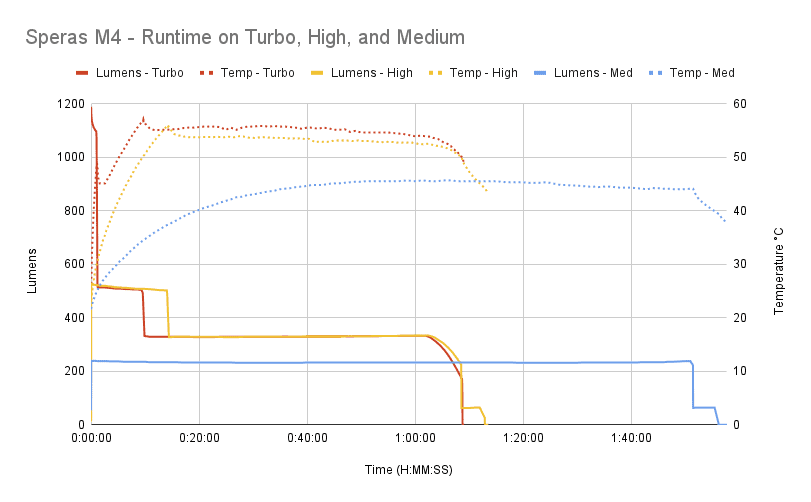
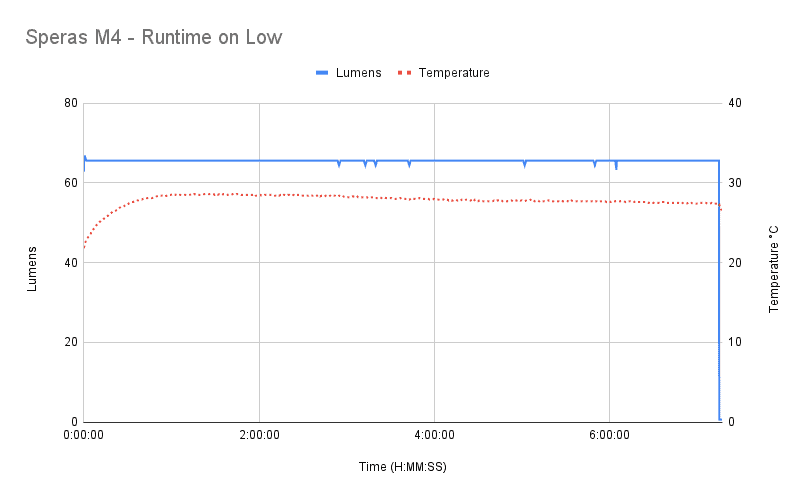
Overall, my test results closely matched Speras’ specs. I measured a little bit lower on Turbo, but otherwise everything else lined up nicely. I have “Time till shut off” listed below, but this time figure is actually when the light dropped down to its 0.6 lumen mode and stayed there for a long time. The light eventually shut off, though I think at that point it tripped the battery’s protection circuit.
| Mode | Specified | Measured runtime (ANSI) | Time till shut off |
|---|---|---|---|
| Eco | 220 hr | – | – |
| Low | 7 hr 45 min | 7 hr 15 min | 7 hr 15 min |
| Medium | 2 hr | 1 hr 56 min | 1 hr 58 min |
| High | 1 hr 15 min | 1 hr 12 min | 1 hr 13 min |
| Turbo* | 1 hr 10 min | 1 hr 9 min | 1 hr 9 min |
ANSI FL1 standards: The runtime is measured until the light drops to 10% of its initial output (30 seconds after turning on). This does not mean that the flashlight is not usable anymore. The last column shows how long the light actually works till it shuts off. If there is a + symbol, it means that the test was stopped at that particular point, but the light was actually still running. This happens on certain occasions, with certain drivers, firmware, or batteries.
Throw numbers: Peak beam intensity
Throw was measured at 10 meters after 30 seconds from turn-on.
| Mode | Specified | Candela measured | Meters | Yards |
|---|---|---|---|---|
| Eco | 75 cd | – | – | – |
| Low | 4,250 cd | 5,600 | 150 | 164 |
| Medium | 17,000 cd | 21,800 | 295 | 322 |
| High | 37,500 cd | 49,300 | 444 | 486 |
| Turbo | 106,400 cd | 107,900 cd | 657 m | 718 y |
Extra info: Peak beam distance according to ANSI FL1 standards: The calculated value of distance in meters at which the flashlight produces a light intensity of 0.25 lux. (0.25 lux is about the brightness of a full moon shining on an object).
Beamshots
Beam shots of the building are taken at 15 m (16 yd) using a Pixel 6 set to ISO 200 with 1/10 second exposure time
Beam shots of the playset are taken at 30 m (33 yd) using a Pixel 6 set to ISO 200 with 1/2 second exposure time. The trees in the background are around 65 m away.
Comparison Speras M4 vs Lumintop GTA vs Wuben E6
- Speras M4
- Lumintop GTA
- Wuben E6
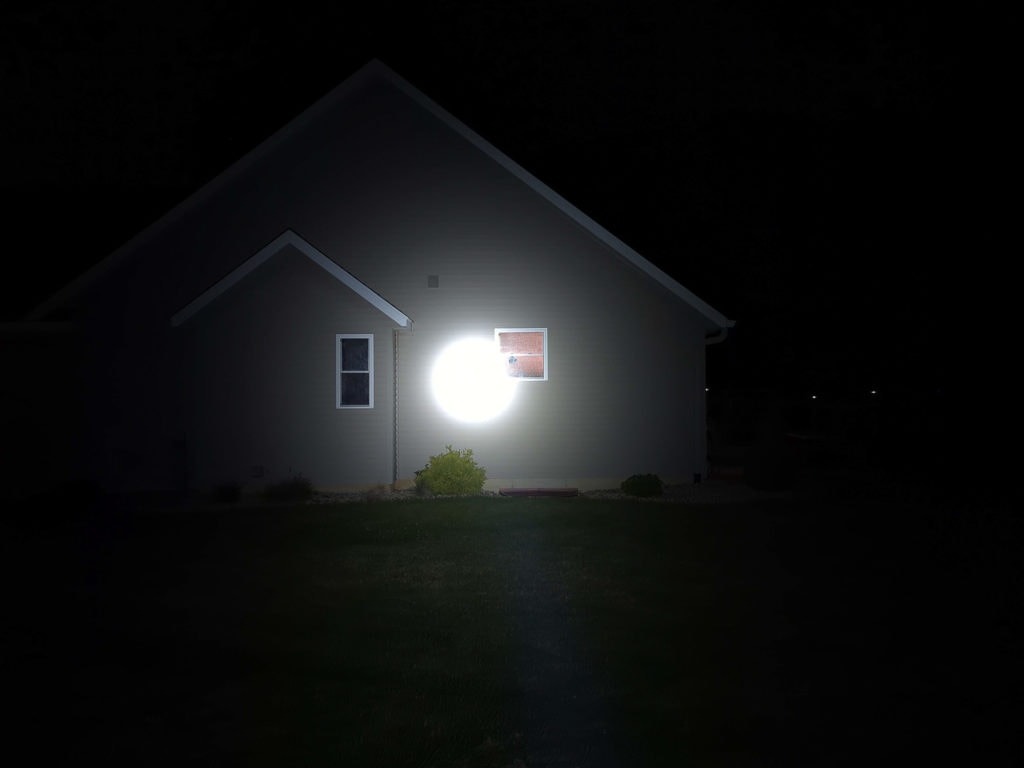
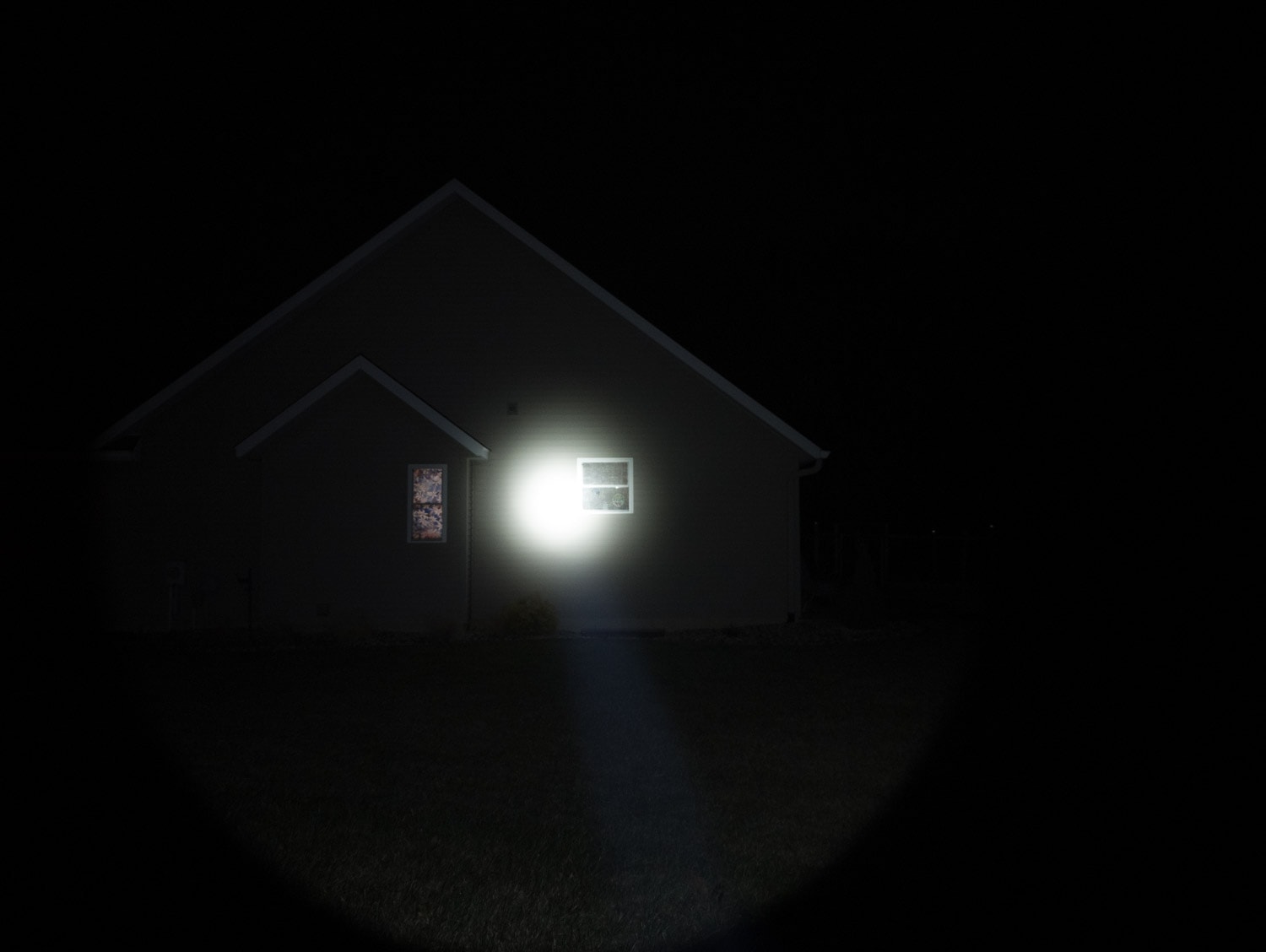
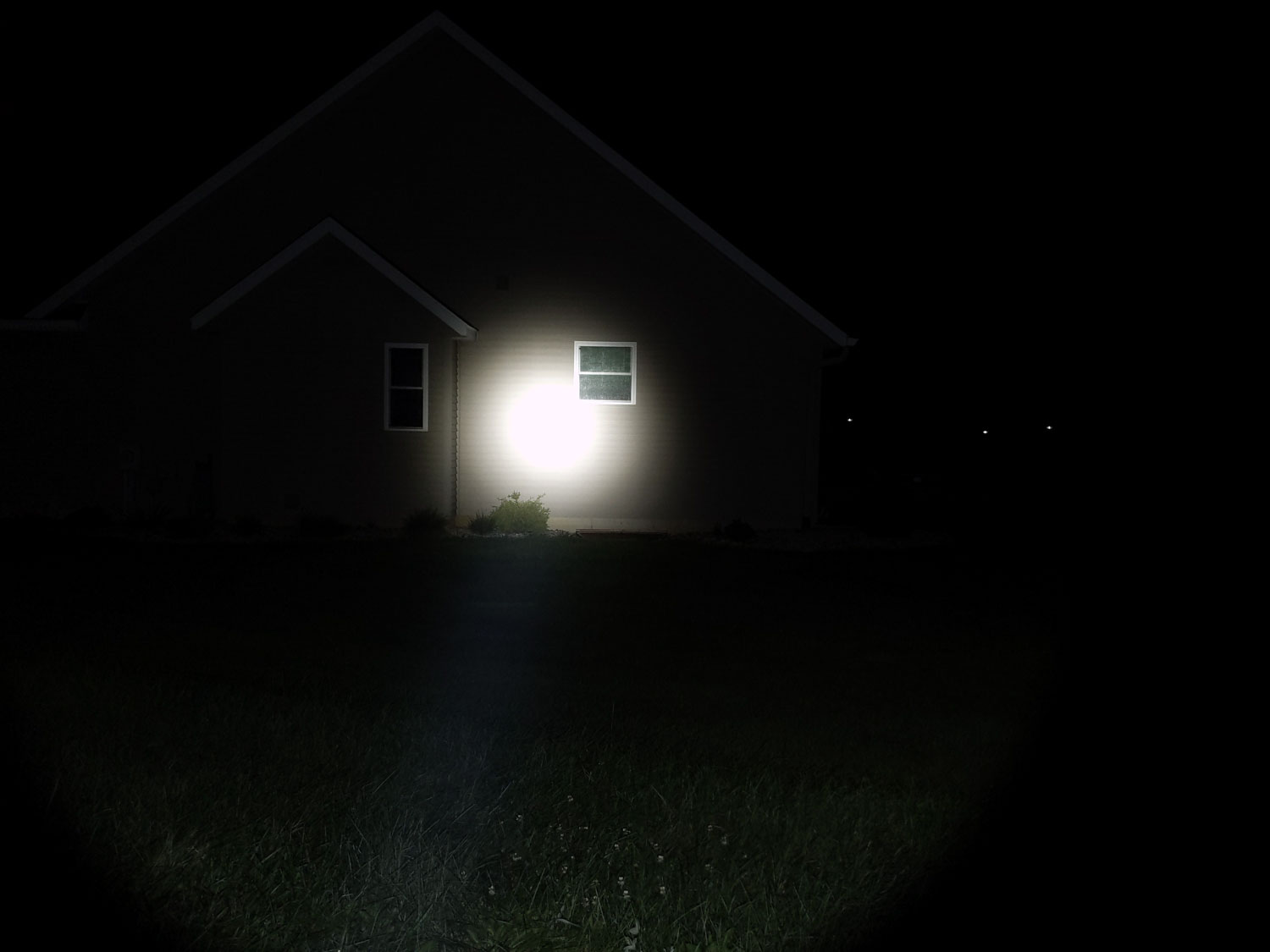
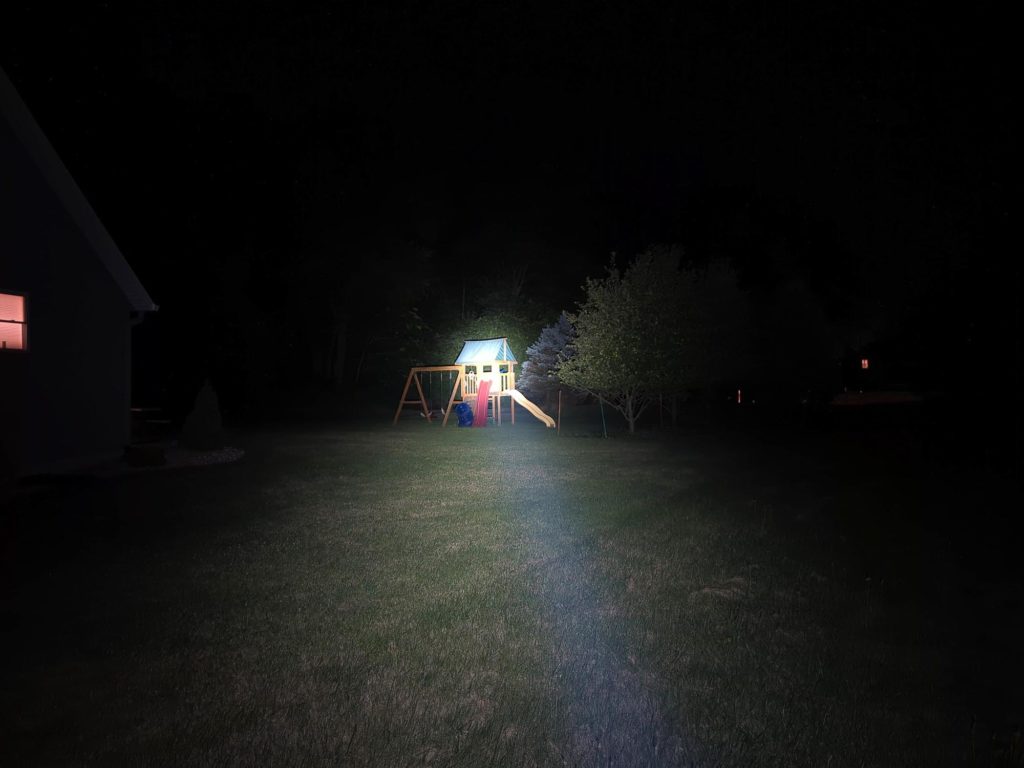
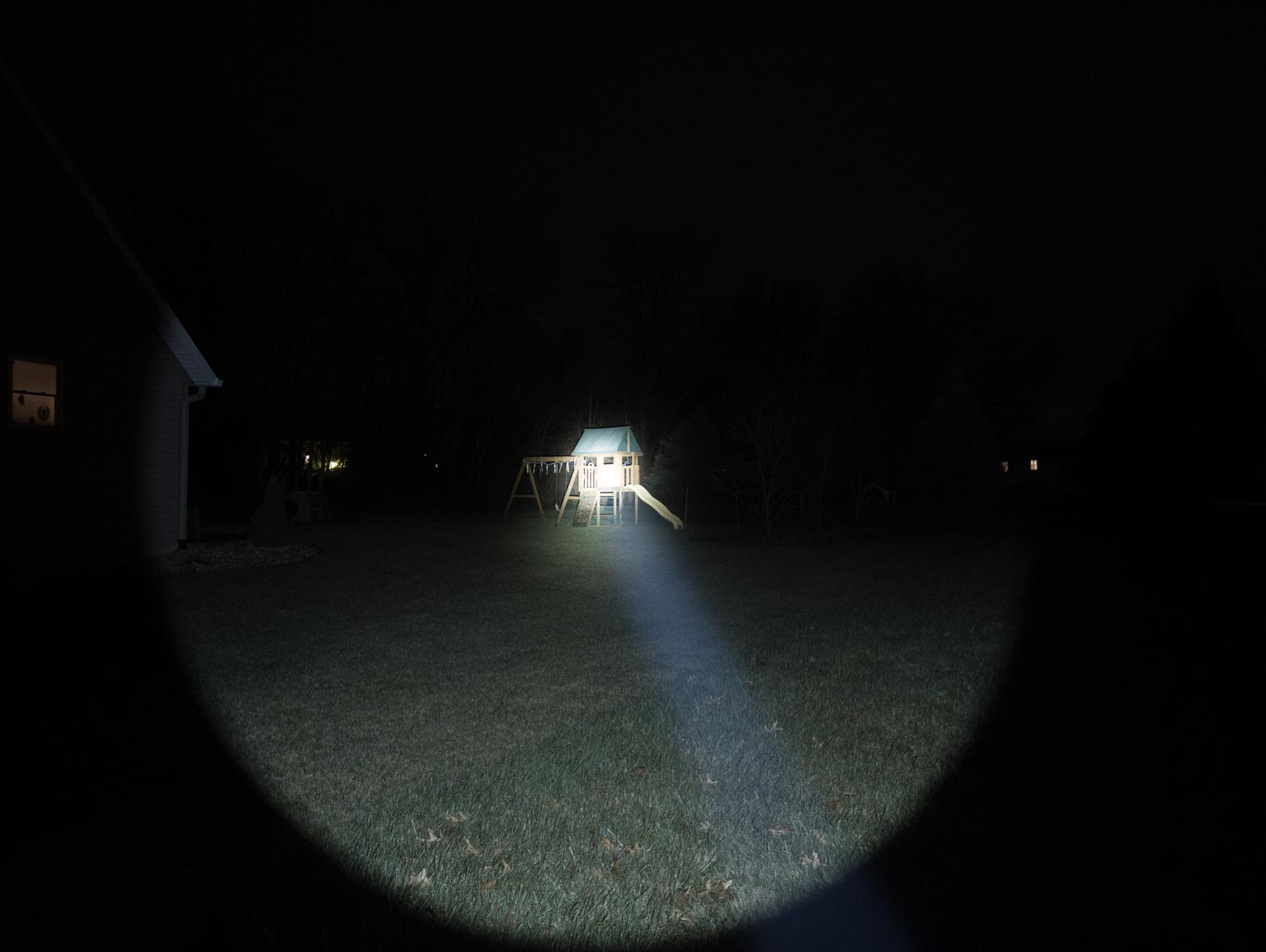
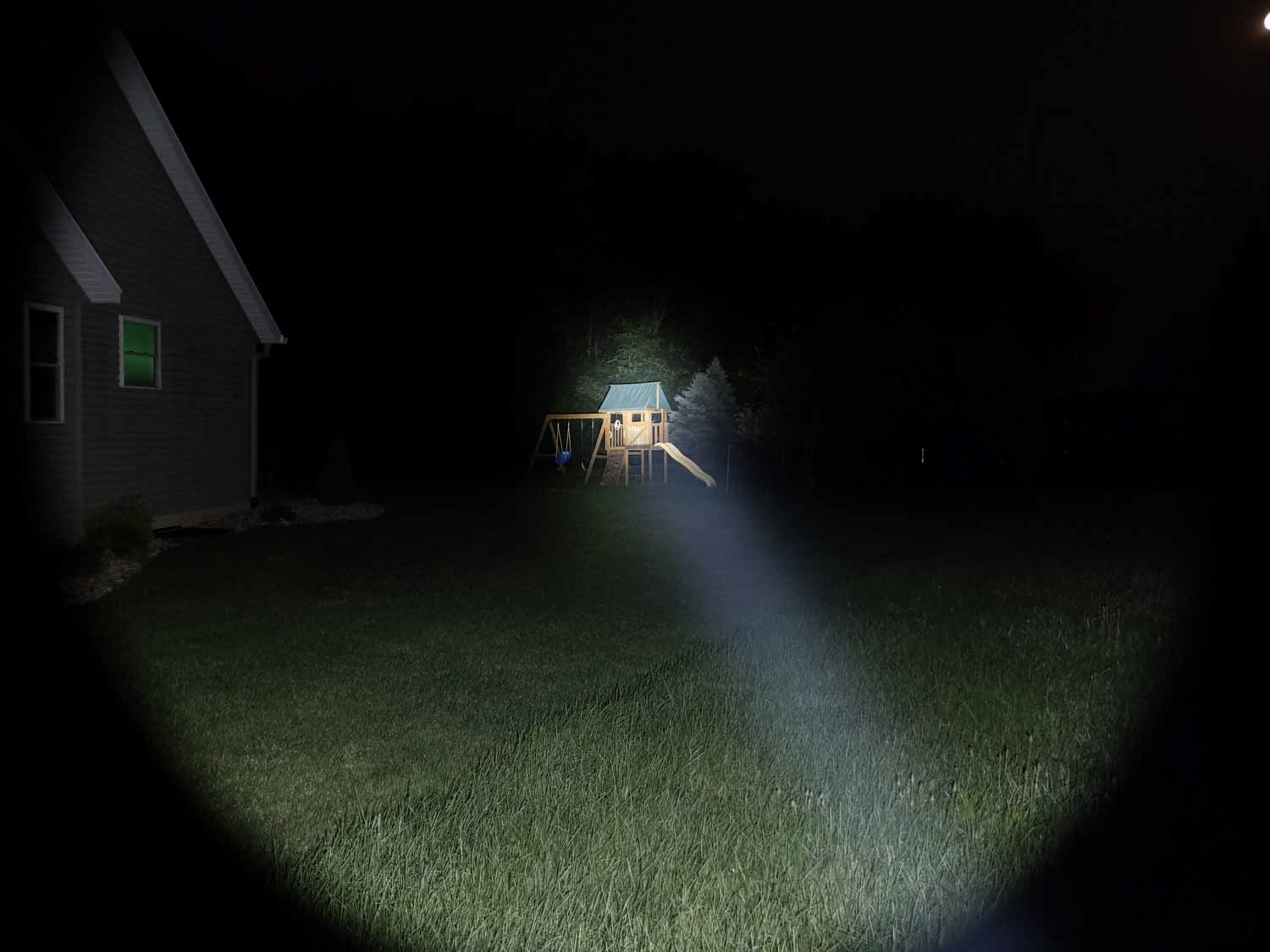
Disclaimer: This flashlight was sent to me for review at no cost by Speras. I have not been paid to review, nor have I been holding back on problems or defects.
Final Verdict
Pros
- Impeccable build quality
- Good looking design
- Truly a mini thrower
- Very nice UI
- USB-C charging
Cons
- Greenish tint
- Doesn’t recognize USB-PD
Explanation on star ratings:
1: Avoid: my phone flashlight would be a better choice – 2: Poor: significant defect or issues; almost unusable – 3: Average: some defects or issues; but still usable 4: Good: recommended (minor issues) – 5: Great: highly recommended

4.5 stars: ★★★★⋆
It’s not very often that I’m surprised by a light when I go to review it. Generally I have some history with the company and I sorta know what to expect. This one though… I wasn’t familiar with the brand. I’ve got to hand it to Speras, I’m genuinely impressed with their new M4 “mini pocket thrower”. It lives up to (most) of its claims and knocks it out of the park with build quality.
Speras M4 For Sale
1lumen selects and reviews products personally. We may earn affiliate commissions through our links, which help support our testing.